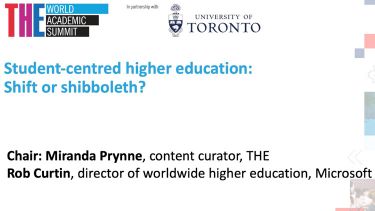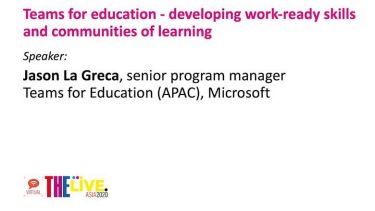Increasing partnerships with industry can help institutions succeed and survive, say experts
The Times Higher Education Student Success Forum 2020 heard that institutions can leverage technology to create a cloud-powered student life cycle where learning and teaching can thrive.
Speaking at the panel discussion “A cloud-powered student life cycle”, Kelly Sundberg, director, education strategy, business applications and power platform at Microsoft, told the forum that universities had an opportunity to transition to new IT systems built with flexibility in mind.
“We’re talking a lot about returning to normal. But is that really what we want? Or do we want to transform into a new normal?” she asked. “That’s where the cloud-powered student life cycle is really key – to ensure you have that flexibility to look forward and interact with whatever you need to face.”
Sundberg added that higher education institutions typically faced three challenges in relation to their IT systems: accidental architecture (a legacy of older technology), technical debt (where a rushed project roll-out now requires fixes) and educational culture (for example, staff being resistant to adopting new systems).
David Minahan, chief information officer at TEDI-London, said the institution had adopted a cloud-first approach with a focus on mixed-mode learning. The design-led engineering school successfully ran a fully remote summer school for 147 students from 21 countries using Microsoft Teams and other systems.
Minahan argued that institutions with older technology should not put off updating their systems.
“You’ve got to try to eat an elephant a bite at a time. The problem doesn’t resolve itself, so at some point you have to make a start,” he said. “The biggest piece of advice I could give anybody senior at a university or higher education institution is to really think about your planning cycles. Think about your budget allocation and how you can shift that to more agile delivery methods.
“What the world is showing us now is the organisations that are going to succeed and survive are those that can respond in more agile ways.”
Minahan added that there were often success stories within universities: for example, a department with an advanced IT structure that the rest of the institution could learn from.
The panel agreed that collaborations between institutions and IT partners should be “genuine partnerships, not just a transactional relationship”.
“The more that we can work in partnership, the more we can transform our industry and transform our institutions,” said Sundberg. “Look back on 2020 as a year that you were able to transform your institution by leveraging the new technology that is out there.”
Watch “A cloud-powered student life cycle” in the link above or on the THE YouTube channel.
Find out more about Microsoft and higher education.









